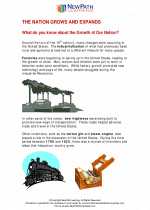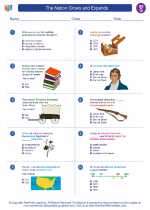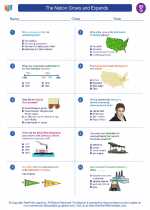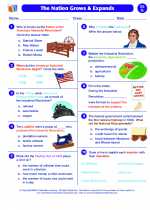The Nation Grows and Expands
Around the turn of the 19th century, many changes were occurring in the United States. The industrialization of what had previously been rural and agricultural land led to a different lifestyle for many people. Read More...
◂Social Studies Worksheets and Study Guides Seventh Grade. The Nation Grows and Expands
Study Guide The Nation Grows and Expands
The Nation Grows and Expands  Worksheet/Answer key
Worksheet/Answer key The Nation Grows and Expands
The Nation Grows and Expands  Worksheet/Answer key
Worksheet/Answer key The Nation Grows and Expands
The Nation Grows and Expands  Worksheet/Answer key
Worksheet/Answer key The Nation Grows and Expands
The Nation Grows and Expands  Worksheet/Answer key
Worksheet/Answer key The Nation Grows and Expands
The Nation Grows and Expands 

 Worksheet/Answer key
Worksheet/Answer key
 Worksheet/Answer key
Worksheet/Answer key
 Worksheet/Answer key
Worksheet/Answer key
 Worksheet/Answer key
Worksheet/Answer key

The resources above cover the following skills:
National Center for History in Schools (NCHS)
Historical Thinking Standards
Historical Comprehension
Reconstruct the literal meaning of a historical passage.
United States History Content Standards
Era 4: Expansion and Reform (1801-1861)
How the industrial revolution, increasing immigration, the rapid expansion of slavery, and the westward movement changed the lives of Americans and led toward regional tensions.
The student understands how the factory system and the transportation and market revolutions shaped regional patterns of economic development.
Era 6: The Development of the Industrial United States (1870-1900)
How the rise of corporations, heavy industry, and mechanized farming transformed the American people.
The student understands the connections among industrialization, the advent of the modern corporation, and material well-being.
Massive immigration after 1870 and how new social patterns, conflicts, and ideas of national unity developed amid growing cultural diversity.
The student understands how new cultural movements at different social levels affected American life.
The rise of the American labor movement and how political issues reflected social and economic changes.
The student understands how the "second industrial revolution" changed the nature and conditions of work.
Era 7: The Emergence of Modern America (1890-1930)
How Progressives and others addressed problems of industrial capitalism, urbanization, and political corruption.
The student understands the origin of the Progressives and the coalitions they formed to deal with issues at the local and state levels.
World History Content Standards
Era 7: An Age of Revolutions, 1750-1914
Patterns of nationalism, state-building, and social reform in Europe and the Americas, 1830-1914.
The student understands the political, economic, and social transformations in the Americas in the 19th century.
Patterns of global change in the era of Western military and economic domination, 1800-1914.
The student understands connections between major developments in science and technology and the growth of industrial economy and society.
Major global trends from 1750-1914.
The student understands major global trends from 1750 to 1914.
Era 8: A Half-Century of Crisis and Achievement, 1900-1945
Reform, revolution, and social change in the world economy of the early century.
The student understands the world industrial economy emerging in the early 20th century.